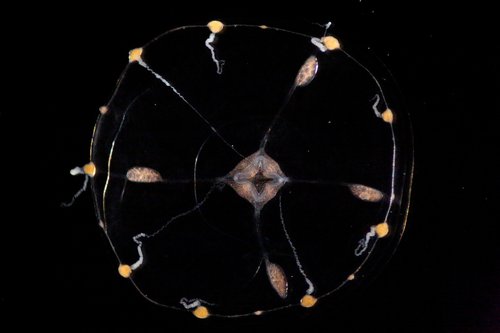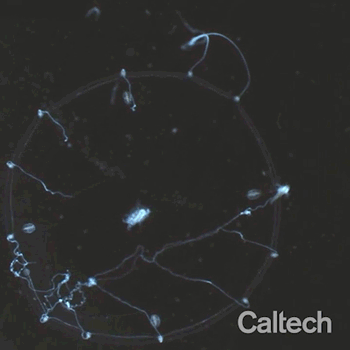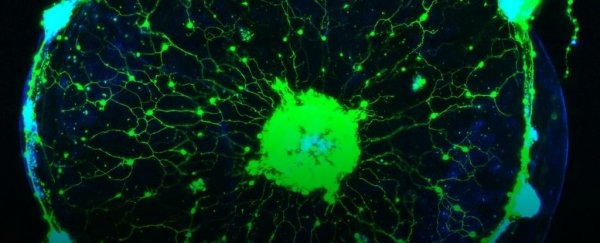Even though jellyfish don't have brains, scientists have figured out a way to read their minds – in a manner of speaking.
With a clever bit of genetic tinkering, we can now watch how the neurons in a tiny species of see-through jellyfish work together to make complex autonomous movements, like grabbing and eating prey.
Clytia hemisphaerica is the perfect model to study for this sort of behavior. Because this specific species of jellyfish is so tiny (only about a centimeter in diameter), it's entire nervous system can easily fit under a microscope.
Its genome is also quite simple, and its transparent body only contains about 10,000 neurons, which makes it easier to track neural messages.
When researchers genetically modified C. hemisphaerica jellyfish so that their neurons glowed when activated, they found an "unanticipated degree of structured neural organization".
Jellyfish nervous systems developed more than 500 million years ago and have changed very little since. Compared to the brains of animals today, the neurons in these 'living fossils' are arranged in a much more simple way.
There is no centralized system coordinating all of the creature's movements, so how does it get anything done?
The new research suggests C. hemisphaerica's neurons are laid out in an umbrella-like network, which closely mirrors its body. These neurons are then further divided into slices, almost like a pie.
Each tentacle on the edge of the jellyfish's bell is connected to one of these slices. So when the jellyfish's arms detect and capture prey, like brine shrimp, the neurons in this one slice are activated in a specific sequence.
 (Weissbourd/DeGiorgis)
(Weissbourd/DeGiorgis)
Above: Clytia hemisphaerica, viewed from above with tentacles arranged uniformly around its outer edges.
First, neurons on the edge of the pie slice send messages to neurons in the middle, where the mouth of the jellyfish is located.
This causes the edge of the pie slice to turn inwards towards the mouth, bringing the tentacle along with it. Meanwhile the mouth, in turn, 'points' towards the incoming food. The video below shows the behavior in action.
 (Weissbourd)
(Weissbourd)
Above: A jellyfish folding the right side of its body to bring a brine shrimp to its mouth.
Within a minute of being introduced to a brine shrimp, the authors found 96 percent of jellyfish attempted this 'food transfer' and 88 percent were successful. Virtually all brine shrimp were eventually eaten by the creatures using this feeding behavior.
To figure out which neurons are specifically triggering this domino effect, researchers deleted a type of neurons called RFa+ neurons on the edge of the pie slice. When they did this, the asymmetric inward folding of the jellyfish bell did not occur, and the transfer of shrimp from tentacles to mouth didn't happen.
"Thus," the authors write, "RFa+ neurons are required for both food-induced and chemically induced margin folding. In contrast, swimming and crumpling were unperturbed, suggesting that other neural cell types control these behaviors."
To see how neurons that control the mouth communicate with neurons that control the jellyfish bell and vice versa, researchers began surgically removing certain body parts.
When the mouths of jellyfish were removed from the equation, the creatures kept trying to pass food from their tentacles to their nonexistent mouths.
Even when the tentacles of a jellyfish were removed, chemical extracts of shrimp introduced to a tank could still trigger the mouth to turn towards the food source.
The findings suggest certain jellyfish behaviors are coordinated through different groups of functionally organized neurons, located around the circumference of the umbrella.
The neuronal network that connects the jellyfish bell to its mouth, for instance, could also connect to the digestive system.
When jellyfish in the study were deprived of food, the authors found they captured prey faster than when they weren't as hungry.
This indicates some sort of neural feedback, which is letting the jellyfish 'know' it needs to fill its digestive system up, putting other specific 'feeding' networks on high alert.
"If this hierarchical view is correct, coordinated behaviors in organisms lacking a central brain may have emerged by duplication and modification of smaller autonomous modules to form functionally interacting super-modules," the authors suggest.
"How these interactions are achieved remains to be determined."
The study was published in Cell.
